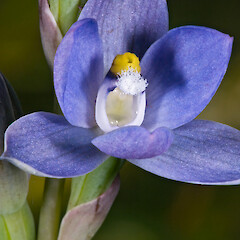Thelymitra tholiformis
Common name
domed sun orchid
Synonyms
None
Family
Orchidaceae
Flora category
Vascular – Native
Endemic taxon
Yes
Endemic genus
No
Endemic family
No
Structural class
Orchids
Chromosome number
2n = 65, c.66
Current conservation status
The conservation status of all known New Zealand vascular plant taxa at the rank of species and below were reassessed in 2017 using the New Zealand Threat Classification System (NZTCS) – more information about this can be found on the NZTCS website. This report includes a statistical summary and brief notes on changes since 2012 and replaces all previous NZTCS lists for vascular plants.
Please note, threat classifications are often suggested by authors when publications fall between NZTCS assessment periods – an interim threat classification status has not been assessed by the NZTCS panel.
- Conservation status of New Zealand indigenous vascular plants, 2017 . 2018. Peter J. de Lange, Jeremy R. Rolfe, John W. Barkla, Shannel P. Courtney, Paul D. Champion, Leon R. Perrie, Sarah M. Beadel, Kerry A. Ford, Ilse Breitwieser, Ines Schönberger, Rowan Hindmarsh-Walls, Peter B. Heenan and Kate Ladley. Department of Conservation. Source: NZTCS and licensed by DOC for reuse under the Creative Commons Attribution 4.0 International licence.
2017 | At Risk – Naturally Uncommon | Qualifiers: Sp
Previous conservation statuses
2012 | Not Threatened
2009 | Not Threatened | Qualifiers: EF
2004 | Sparse
Distribution
Endemic. New Zealand: North Island (Te Paki south to northern Waikato).
Habitat
A species favouring open clay pans, gumland scrub, or sparsely vegetated slopes in site where there once was, or still is kauri (Agathis australis (D.Don) Lindl.) forest. It may also colonise grassy verges along roadsides traversing kauri forest remnants and gumland scrub. This species responds well to periodic burning provided of course the former habitat had few or no fire-adapted weed species.
Detailed description
Stout plants either solitary or forming colonies, up to 0.6 m tall at flowering. Leaf up to 360 × 15 mm,green, often reddish-green near margins and base, linear-lanceolate, sub-erect, shallowly concave with exterior ridges on mature plants. Basal sheath up to 30 mm long, pale, truncate, mucronate. Stem bracts 2, 20–90 × 3–6 mm, lanceolate, sheathing in basal ½–⅔. Floral bracts 10–20 × 3–6 mm, lanceolate. Inflorescence 1–15-flowered. Flowers 10–15 mm diameter, pale to strong mauve, on short pedicels. Perianth cupped, parts ovate, apiculate, up to 12 × 5 mm; sepals narrower than petals; petals minutely papillate externally. Column 5 mm tall, erect, concave in side view, pale purple with yellow striae and a narrow purple band near top. Post-anther lobe as high as or exceeding anther, tholiform (dome-shaped) not hooded (cucullate), bright yellow, margin irregularly denticulate. Column arms more or less terete, horizontal or upturned, with short, dense, globose tufts of white cilia. Anther erect, apex pointed, sometimes curving forward. Stigma short, broad, more or less concave, bilobed; rostellum orbicular, very prominent. Capsule 10–15 × 5–7 mm, elliptic, green.
Manaaki Whenua Online Interactive Key
Similar taxa
Most likely to be confused with Thelymitra aemula Cheeseman and T. ixioides Sw., species with which it often grows. From T. ixioides, T. tholiformis can be immediately distinguished by its unspotted darker mauve flowers, and smooth, green leaves with reddish margins and ridges rather than reddish-green to glaucous silvery reddish-green leaves whose surfaces are finely rough to the touch. From T. aemula, T. tholiformis may be distinguished by its smaller overall size (0.4–0.6 cf. 0.7–0.9 m), narrow-linear rather than linear leaves that are coloured green with reddish margins and ridges, rather than dark green with reddish bases. The column of T. aemula is coloured white to mauve, flushed darker mauve near the apex, whereas in T. tholiformis the column is coloured pale purple with yellow striae and a purple band near the apex. In T. aemula the column has a prominent low, forward projecting fleshy yellow side lobe which is absent in T. tholiformis. Thelymitra tholiformis has 2n = 66 chromosomes, while T. aemula has 2n = 40 and T. ixioides 2n = 28.
Flowering
(October)–November–(December)
Flower colours
Violet/Purple, White
Fruiting
October–February
Propagation technique
Difficult. Should not be removed from the wild.
Threats
Habitat loss and plant collectors. This species is usually associated with kauri forest remnants and gumland. In gumland it is very vulnerable to habitat modification and from competition by weed species. Fires seem to temporarily benefit this orchid which increases in abundance soon after a fire. Some populations near to Auckland have been seriously damaged by plant collectors. Despite these losses, over all the species appears to be much common than was once thought, having an apparently naturally sparse distribution.
Etymology
thelymitra: Woman’s hat
Where To Buy
Not commercially available
Attribution
Fact Sheet prepared for NZPCN by P.J. de Lange 14 April 2007. Description subsequently published in Rolfe & de Lange (2010).
References and further reading
Rolfe JR, de Lange PJ. 2010. Illustrated guide to New Zealand sun orchids, Thelymitra (Orchidaceae). Jeremy Rolfe, Wellington, NZ. 57 p.
NZPCN Fact Sheet citation
Please cite as: de Lange, P.J. (Year at time of access): Thelymitra tholiformis Fact Sheet (content continuously updated). New Zealand Plant Conservation Network. https://www.nzpcn.org.nz/flora/species/thelymitra-tholiformis/ (Date website was queried)










